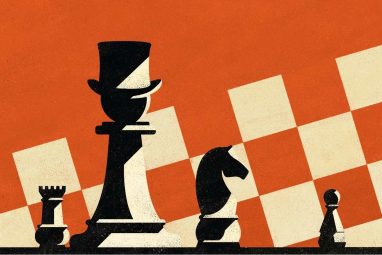Strategizing Across Organizations
Capitalizing on big opportunities and solving systemic problems will require organizations to come together to develop strategies as a group.

Businesses, nonprofits, policy makers, and others frequently find it helpful to come together in networks of organizations to tackle large-scale challenges, such as COVID-19, extreme weather events, humanitarian disasters, or supply chain disruptions. But devising strategy in such meta-organizations is far different from strategizing within a single organization — and much more difficult. A new approach to collaborative strategy can help leaders in individual organizations work with others to achieve both shared and individual strategic priorities.
Meta-organizations (a term coined by Göran Ahrne and Nils Brunsson) can range from tightly organized and well-established trade groups like the International Air Transport Association to loosely structured, short-lived groups like the U.K.’s Brexit Business Taskforce.
One example of a meta-organization is the Global Outbreak Alert and Response Network (GOARN), which comprises more than 250 partner organizations. It works to ensure that resources rapidly reach those who request support during international public health crises. GOARN’s operations are based at the World Health Organization’s headquarters in Geneva, where it is governed by a 21-member steering committee. In late 2021, the committee was facing uncertainty about the outcome of the pandemic and the future that GOARN would face. GOARN’s partners — which include United Nations bodies, international humanitarian organizations, government public health agencies, and technical networks — were calling for it to expand its mission. These diverse organizations have expertise in logistics, emergency medical care, incident response training, operational research, epidemiological investigation, and other domains, which they bring to bear on many different public-health emergencies every year. GOARN’s leadership realized that the network needed to evolve, which would require the development of a new long-term strategy that would meet the needs of both the collective as a whole and each partner.
Leaders working to set strategy in meta-organizational collectives like GOARN will encounter several challenges. Even well-established meta-organizations often lack a well-defined hierarchy, which means that decisions can’t simply be handed down from the top; negotiation, voting, and nonbinding rules are needed to coordinate action. Leaders have to manage tensions between the collective and its members, who can jealously guard their identities and autonomy. There is also a risk of inertia and complacency if member organizations feel they have little or no stake in the direction of the group as a whole.
We have developed a methodology to help guide meta-organizations through the process of devising strategies collectively. It is designed to facilitate a complex discussion so that groups can consider potential changes in the environment in which they operate, examine how they might need to be configured to respond to those changes, and ways to safely experiment and explore new opportunities.
There is a risk of inertia and complacency if member organizations feel they have little or no stake in the group as a whole.
Our approach has three components. The first is scenario planning, where participants explore alternative futures and test assumptions about the environment that the meta-organization and its member organizations might find themselves in when the plan is up and running.
The second is assessing each scenario for value-creating systems to derive value from interactions among all the participants in the network.1 Based on this assessment, participants configure new systems that are intended to create value for the group and its members. They also consider commonalities among the value-creating systems in all scenarios and the ways in which each of them might be put into practice.
Finally, there is ongoing socializing, which brings participants together to discuss the strategy and its possible outcomes and, subsequently, to adapt the adopted strategy so that it becomes a living process and not merely a one-off, formal, and static document.2
An essential feature of the methodology is a strategy lab that allows participants to take time out from day-to-day business to create new strategic directions in pursuit of their shared goals. A strategy lab can be convened online, in person, or as a mix of the two and can be customized to meet the unique needs and goals of participants. The GOARN strategy lab, created in the midst of the COVID-19 pandemic, was all virtual and included two workshops, in October and November 2021, followed by a final, large-scale session in December.
We applied this methodology to support GOARN in developing a new four-year strategy. Faced with calls from partners that the network do more — provide more training, conduct more research, and focus more on preparedness for the next crisis — leaders set out to revisit the network’s strategic priorities. This led to a collaboration with the University of Oxford’s Saïd Business School to run what became known as the GOARN Collaborative Strategy Lab.
Members of the GOARN steering committee and representatives of its partner organizations met via teleconference for the series of workshops. Following the three-phased methodology outlined above, a group of facilitators from Oxford led two sessions largely with steering committee members to explore scenarios and develop value-creating systems for each scenario. In the third and final session, leaders of many GOARN partners met virtually to explore the strategic implications of the work of the previous two sessions.
Key Considerations for Strategizing in Meta-Organizations
Based on our experience in the strategy lab, we identified several important points that organizational leaders should keep in mind when setting a collective strategy.
Establish shared meaning. Even the concept of strategy may mean something different to each of the participants involved in strategy-making. For instance, early in the GOARN strategy lab sessions, some participants equated it with adding new activities, while others thought it meant determining how to improve what was already being done. Therefore, it is advisable to set aside time to get a shared sense of what key terms mean, especially those that are not self-evident. Multiple definitions are acceptable as long as the differences are understood and accepted.
Understand how the parts fit within the whole. Sometimes individual member organizations, especially small or locally focused ones, don’t know how the whole meta-organization operates, because they have been exposed to only small parts of it. They in turn don’t see how their own actions benefit the organization as a whole and might fail to fully appreciate how it benefits them. When devising a collective strategy, it is useful to keep in mind the idea of the holographic organization — in which the whole and its parts interact for mutual benefit.3 For GOARN, this implies that its full global potential can be manifested, at a smaller or larger scale, in each intervention that its partners undertake — to deal with an outbreak of Ebola, cholera, or mpox, for example — wherever it might occur. In meta-organizations, this means making sure that each partner can mobilize the resources of the whole network while ensuring that each part can be tapped to contribute to the effectiveness of the whole.
Pay attention to relationships and power differences. In meta-organizations, the power to direct action is not as strong as it is in hierarchical organizations, because members have more resources and are far better equipped to take action on their own than individuals in a hierarchy. In this setting, it’s critical to strengthen the network’s social capital by developing a shared language; enhancing trust, respect, and empathy; and forging new links.
Politics and culture are also far more important considerations in meta-organizations than within individual members. Research has shown that the interests of the most powerful members can dominate while the less powerful struggle to have an effective role.
In the GOARN lab, this issue was addressed by inviting all members to participate in the process of defining the strategy rather than merely react to a draft strategic plan crafted by leaders. Participants were able to step back from their specific areas of expertise and discuss big-picture problems with others who might be working on different challenges. They found the opportunity to engage in this consultative process outside of the context of urgent emergency responses deeply rewarding.
It is also important to recognize how political and cultural considerations and language might affect the ability of some participants to fully engage. Attending to such differences is an important aspect of strategizing in such settings because they can have an impact on the quality of discussions.
Reinforce a shared sense of purpose. A single organization can be a member of multiple networks at the same time, making boundaries and allegiances more complicated. This requires a meta-organization to find ways to ensure that members’ interests are compatible even if they cannot be fully aligned.
The leaders of a meta-organization must define an identity that reinforces a sense of shared purpose and create goals that harmonize the network and its members. Achieving this harmony isn’t easy and will vary from one collective to another. It is advisable to anticipate in advance how much divergence from these shared goals is tolerable and to identify governance mechanisms for addressing deviations early and constructively.
Benefits of the Strategy Lab Approach
GOARN’s strategic outlook for the next four years was finalized in June 2022. Before then, the strategy lab had already yielded positive outcomes for the network, as well as insights into effective strategizing practices for meta-organizations in general.
For GOARN, which was accustomed to constantly moving from one crisis to the next, the strategy lab created the opportunity to look beyond day-to-day operational questions. Members could bring to light existing assumptions and ensure that “today’s events do not define tomorrow’s outcomes,” in the words of one participant. It also enabled the network to mobilize the considerable diversity of its partners to develop a robust, well-accepted strategy.
The lab’s use of multiple scenarios made it easier to acknowledge and incorporate divergent perspectives. GOARN leaders could consider possibilities that had not previously occurred to them, and they could also discuss future challenges and opportunities GOARN might face and novel options for action. For instance, partners could discuss a scenario where collaboration between countries has broken down, what that might mean for the meta-organization at an operational level, and where value could be offered. Finally, participants believed that the strategy lab methodology increased their sense of ownership of both the strategy and GOARN as a whole.
Our experience with the GOARN strategy lab also provided the following insights about how other meta-organizations could create beneficial conditions for working on a collective strategy.
- Ensure that each member of the collective can tap the broader assets of the network to carry out its own activities, that its own contributions are valued by other members and the collective as a whole, and that strategies can be implemented in a way that is best suited to each partner/member and reflects their priorities.
- Foster a culture that accepts differences and sees advantage in diversity. The use of scenarios can help articulate different views and show them as plausible, acceptable, legitimate, and relevant. This enhances understanding of the differences and can even help such disagreements to become productive assets rather than liabilities to be papered over.
- Establish a mechanism, such as the strategy lab, to periodically revisit the group’s common ground, update how it is understood, and decide what to keep in and remove from the collective strategy. Strategizing is an iterative process linked to a program of monitoring, evaluation, and learning.
- Recognize that developing strategy is more about defining and prioritizing goals and the activities needed to accomplish them than it is about adding ever more targets and activities.
- Facilitate conversations that are challenging, courageous, respectful, inclusive, productive, relevant, encouraging, and action-oriented.
Organizations operating in turbulent times can benefit from banding together to enhance their resilience and to find or create new opportunities. A lab-based approach to setting strategy offers a safe and creative space to explore alternatives, understand different opinions, reinterpret identities, and codesign the collective relationships required to work together effectively.
Ultimately, however, a strategy is useful only if it is implemented through the leadership of the meta-organization and its member/partner institutions. It requires a commitment to follow through with monitoring and evaluation, and the strong governance of well-resourced meta-organization leadership and operational support teams. Only then will a meta-organizational strategy lead to coordinated activities by member organizations that further the goals of the collective.




